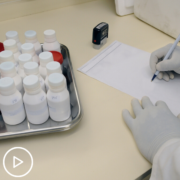Notable New MPN Treatments
Notable New MPN Treatments from Patient Empowerment Network on Vimeo.
What’s the latest in myeloproliferative neoplasm (MPN) treatments? Dr. Kristen Pettit from Rogel Cancer Center gives updates about treatment developments for myelofibrosis, polycythemia vera (PV), and essential thrombocythemia (ET) care including JAK inhibitors, BCL-2 inhibitors, BCL-XL inhibitors, BET inhibitors, and others.
See More From the MPN TelemEDucation Resource Center
Related Resources:

|

|

|
Transcript:
Dr. Kristen Pettit:
There are so many new treatments in MPNs that I’m excited about, so one that is investigational that has been moving through the pipeline is momelotonib, which is a newer JAK inhibitor for patients with myelofibrosis. The mechanism of action is slightly different than the other JAK inhibitors, ruxolitinib (Jakafi), baricitinib (Olumiant), and pacritinib that’s improved as well.
The hope with momelotonib is that it will do some of the good things that the other JAK inhibitors do reduce symptoms and reduce spleen size, but also potentially improve anemia for patients who struggle with anemia, which is such a high proportion of our patients with myelofibrosis. I think that’s one exciting thing, another exciting avenue are new potential up-front treatment strategies that are being studied, so there are a number of different clinical trials going on right now, testing the strategy of either standard ruxolitinib or Jakafi by itself compared head-to-head versus a combination of Jakafi plus another medication.
Those other medications that are being tested in trials include the BET inhibitor called parsaclisib, also BCL-2, BCL-XL inhibitor called navitoclax, and a Pi3 Kinase inhibitor called parsaclisib. These upfront head-to-head treatment strategies are going to be very important to keep an eye out for over the next couple of years. The hope is that these combination strategies could deepen responses and potentially prolong responses when a new drug is combined with the JAK inhibitor as the first treatment option for patients with myelofibrosis. In the later line setting, one thing that’s exciting is Imetelstat, which is a telomerase inhibitor.
This is the first study in my myelofibrosis that is trying to specifically prove whether or not it is linked in survival for patients with myelofibrosis. So, I think that’s very exciting and something to keep an eye out for.
In polycythemia vera, one newer treatment option that’s getting a lot of excitement is the Hepcidin mimetic called rusfertide, this medication will hopefully harness the body’s iron metabolism pathway and act as sort of a chemical phlebotomy as opposed to an actual therapeutic phlebotomy in order to control the hemoglobin and hematocrit for patients with PV as well as improve symptoms.
In ET the newer agents that are being investigated include the BET inhibitor parsaclisib, is also being studied for myelofibrosis as well as an LSD-1 inhibitor called bomedemstat. Both of these look exciting so far, as far as their ability to both control platelet count and improve symptoms for patients with ET.


![Spanish [ACT]IVATED MPN Resource Guide](https://powerfulpatients.org/wp-content/uploads/Spanish-ACTIVATED-MPN-Resource-Guide-180x180.png)






